KPE 160 Study guides, Study notes & Summaries
Looking for the best study guides, study notes and summaries about KPE 160? On this page you'll find 26 study documents about KPE 160.
Page 2 out of 26 results
Sort by
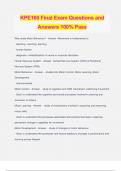
-
KPE160 Final Exam Questions and Answers 100% Pass
- Exam (elaborations) • 34 pages • 2024
- Available in package deal
-
- $13.49
- + learn more
KPE160 Final Exam Questions and Answers 100% Pass Why study Motor Behaviour? - Answer- Movement is fundamental to: - teaching, coaching, learning - human factors - diagnosis / rehabilitization of neural or muscular disorders Human Nervous System - Answer- Central Nervous System (CNS) & Peripheral Nervous System (PNS) Motor Behaviour - Answer- - divided into Motor Control, Motor Learning, Motor Development - interconnected Motor Control - Answer- - study of cognitive and CNS mechanism ...
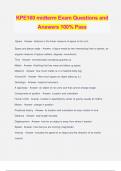
-
KPE160 midterm Exam Questions and Answers 100% Pass
- Exam (elaborations) • 10 pages • 2024
- Available in package deal
-
- $7.99
- + learn more
KPE160 midterm Exam Questions and Answers 100% Pass Space - Answer- distance is the linear measure of space (m,km,cm) Space and planar angle - Answer- a figure made by two intersecting lines or planes, an angular measure of space (radians, degrees, revolutions) Time - Answer- monotonically increasing quantity (s) Matter - Answer- Anything that has mass and takes up space Mass(m) - Answer- how much matter is in a material body (kg) Volume(V) - Answer- How much space an object takes up (L)...
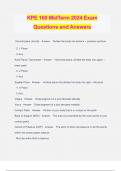
-
KPE 160 MidTerm 2024 Exam Questions and Answers
- Exam (elaborations) • 30 pages • 2024
- Available in package deal
-
- $13.49
- + learn more
KPE 160 MidTerm 2024 Exam Questions and Answers Coronal plane (frontal) - Answer- - Divides the body into anterior + posterior portions - Z, Y Plane - X Axis Axial Plane (Transverse) - Answer- - Horizontal plane, divides the body into upper + lower parts - X, Z Plane - Y Axis Sagittal Plane - Answer- - Vertical plane that divides the body into right + left parts - Y, X Plane - Z Axis Valgus - Answer- - Distal segment of a joint deviates laterally Varus - Answer- - Distal segment of ...
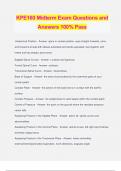
-
KPE160 Midterm Exam Questions and Answers 100% Pass
- Exam (elaborations) • 10 pages • 2024
- Available in package deal
-
- $12.49
- + learn more
KPE160 Midterm Exam Questions and Answers 100% Pass Anatomical Position - Answer- spine in neutral position, eyes straight forwards, arms and forearms at side with elbows extended and hands supinated, feet together with knees and hip straight, penis erect Sagittal Spinal Curves - Answer- Lordosis and kyphosis Frontal Spinal Curve - Answer- scoliosis Transverse Spinal Curve - Answer- rotoscoliosis Base of Support - Answer- the area circumscribed by the outermost parts of your contact pat...
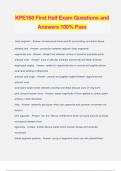
-
KPE160 First Half Exam Questions and Answers 100% Pass
- Exam (elaborations) • 11 pages • 2024
- Available in package deal
-
- $12.49
- + learn more
KPE160 First Half Exam Questions and Answers 100% Pass body segment - Answer- bone/several bones and its surrounding connective tissue skeletal joint - Answer- connection between adjacent body segments segmental axis - Answer- straight line between centres of proximal and distal joints articular axes - Answer- axes of articular surfaces at proximal and distal surfaces diaphyseal angles - Answer- relative to segmental axis in coronal and sagittal planes axial lane twisting of diaphyses ar...
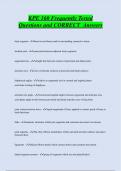
-
KPE 160 Frequently Tested Questions and CORRECT Answers
- Exam (elaborations) • 11 pages • 2024
-
- $8.49
- + learn more
body segment - bone/several bones and its surrounding connective tissue skeletal joint - connection between adjacent body segments segmental axis - straight line between centres of proximal and distal joints articular axes - axes of articular surfaces at proximal and distal surfaces diaphyseal angles - relative to segmental axis in coronal and sagittal planes axial lane twisting of diaphyses
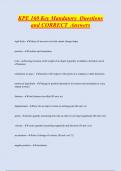
-
KPE 160 Key Mandatory Questions and CORRECT Answers
- Exam (elaborations) • 29 pages • 2024
-
- $8.49
- + learn more
rigid body - object of non-zero size that cannot change shape position - location and orientation CoG - average location of all weight of an object (typically in midline a bit below navel of humans) orientation in space - position with respect to the points of a compass or other directions motion of rigid body - change in position denoted by its location and orientation at every instant in time) distance - total distance travelled (SI unit: m) displacement - how far an object is from i...
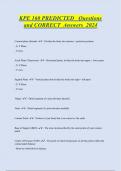
-
KPE 160 PREDICTED Questions and CORRECT Answers 2024
- Exam (elaborations) • 27 pages • 2024
-
- $8.49
- + learn more
Coronal plane (frontal) - - Divides the body into anterior + posterior portions - Z, Y Plane - X Axis Axial Plane (Transverse) - - Horizontal plane, divides the body into upper + lower parts - X, Z Plane - Y Axis Sagittal Plane - - Vertical plane that divides the body into right + left parts - Y, X Plane - Z Axis Valgus - - Distal segment of a joint deviates laterally Varus - - Distal segment of a joint deviates medially Contact Patch - - Portion of your body that is in contact w/ ...
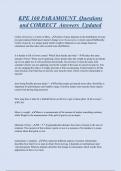
-
KPE 160 PARAMOUNT Questions and CORRECT Answers Updated
- Exam (elaborations) • 16 pages • 2024
-
- $8.49
- + learn more
Centre of Gravity vs Centre of Mass - centre of mass depends on the distribution of mass (not gravitational field) and it doesn't change even if you move or orient yourself differently. Centre of gravity is a unique point which weight is balanced, it can change based on orientation and also takes into account mass distribution. Is it harder to lift or lower a mass? Which feels harder and why? - It takes the same amount of force. When you're applying a force greater than the weight its...
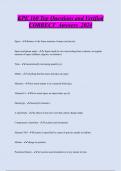
-
KPE 160 Top Questions and Verified CORRECT Answers 2024
- Exam (elaborations) • 11 pages • 2024
-
- $7.99
- + learn more
Space - distance is the linear measure of space (m,km,cm) Space and planar angle - a figure made by two intersecting lines or planes, an angular measure of space (radians, degrees, revolutions) Time - monotonically increasing quantity (s) Matter - Anything that has mass and takes up space Mass(m) - how much matter is in a material body (kg) Volume(V) - How much space an object takes up (L) Density(p) - mass(m)/volume(v)

Did you know that on average a seller on Stuvia earns R4500 per month selling summaries? Hmm, hint, hint. Discover all about earning on Stuvia


